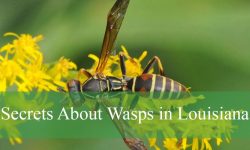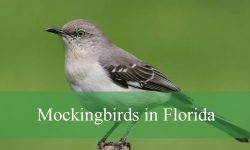Georgia’s wetlands and forests shelter a variety of frogs and toads, ranging in size from small chorus frogs to large bullfrogs. The state’s wetlands, forests, and rivers provide ideal habitats, supporting over 30 species. Whether you’re a wildlife enthusiast or a casual observer, Georgia’s frogs offer fascinating behaviors and colorful patterns to explore.
Many of these species are easy to identify by their distinctive calls, markings, and size. From the bright green treefrogs that climb shrubs to the camouflaged toads hidden in leaf litter, each species has unique adaptations for survival. Understanding these characteristics can help you recognize them in the wild.
This guide covers the 25 most common frogs and toads in Georgia, complete with identification details, behavior insights, and habitat preferences. It’s designed to help beginners and experienced herpetologists alike appreciate the rich amphibian diversity of the state.
Different Types of Frogs Found in Georgia
Eastern Spadefoot (Scaphiopus holbrookii)
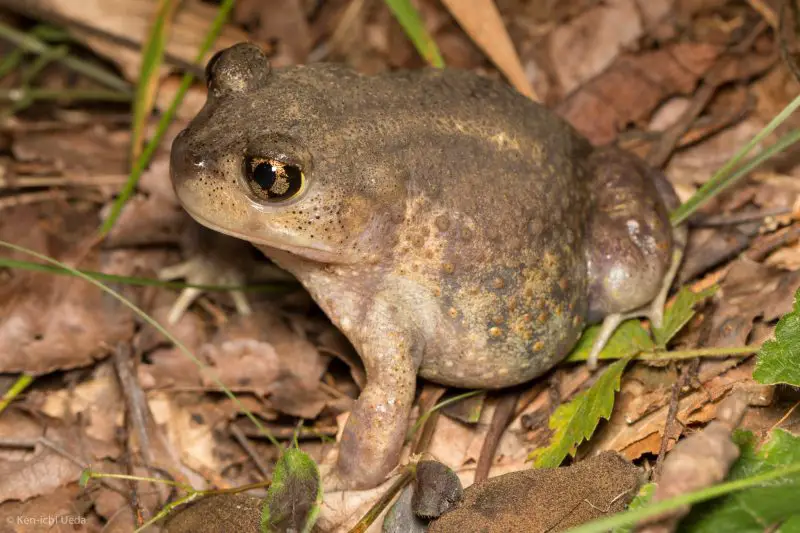
The Eastern Spadefoot is a small, stocky frog ranging from 1.5 to 2.5 inches long. Its skin is smooth with variable brown, gray, or olive coloring, often featuring a faint light stripe along the back. A key feature is the hard, keratinized spade on each hind foot, which it uses to dig backward into sandy soil. Its eyes are golden or coppery with vertical pupils, giving it a distinctive nocturnal appearance.
Eastern Spadefoots are primarily fossorial, spending most of their lives buried underground. They emerge at night, especially after heavy rains, to feed on insects, spiders, and other invertebrates. They are explosive breeders, meaning that large numbers appear in temporary pools during rainfall events to reproduce over a very short period.
Their preferred habitats include sandy soils, pine flatwoods, and open fields in Georgia. Breeding occurs in ephemeral rain-filled pools, which reduces predation on eggs and tadpoles. Females lay small clusters of eggs that hatch rapidly, and tadpoles grow quickly to complete metamorphosis before the pools dry. This rapid development is essential for survival in their unpredictable environments.
Northern Cricket Frog (Acris crepitans)
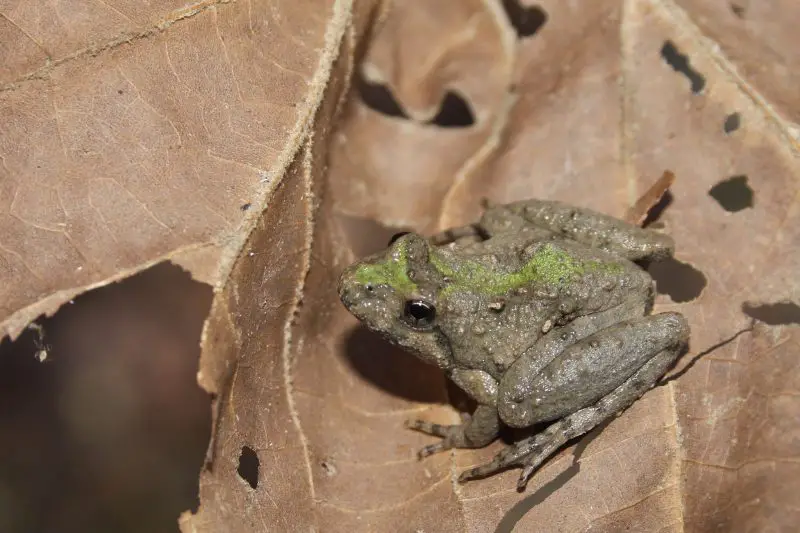
The Northern Cricket Frog is a tiny frog, only about 0.75 to 1.5 inches long. Its skin is rough with dark, irregular blotches on a gray or brown background. One notable identification feature is the bright, contrasting triangular mark between the eyes. Its long, slender legs allow for short, quick hops rather than long jumps.
This species is diurnal and highly aquatic, often found near the edges of ponds, streams, and marshes. It feeds on small insects and spiders, using its quick reflexes and sticky tongue. Despite its small size, it can be surprisingly agile and often escapes predators by rapidly leaping into water.
Northern Cricket Frogs prefer shallow, slow-moving freshwater habitats in Georgia, particularly in lowland regions. Breeding occurs in spring and summer, with males producing a short, metallic “crick” call. Females lay clusters of eggs attached to submerged vegetation, and tadpoles complete development within weeks. Their reliance on water makes them sensitive to habitat changes such as drought or pollution.
Southern Cricket Frog (Acris gryllus)
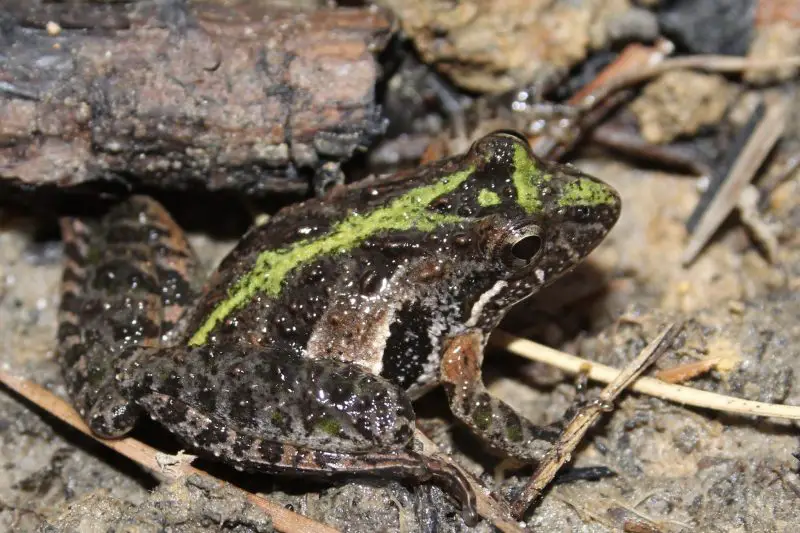
The Southern Cricket Frog is similar in size to the Northern Cricket Frog, generally ranging from 0.75 to 1.25 inches long. Its coloration is typically gray, brown, or olive with a distinct triangular mark between the eyes. It has long hind legs for short hops and a stocky body, giving it a characteristic crouched posture when at rest.
Southern Cricket Frogs are active during the day and night, usually near aquatic environments such as marshes, ponds, and ditches. They feed primarily on small insects and other invertebrates. Their quick hopping movements help them evade predators like snakes, birds, and larger frogs. Despite being tiny, their calls are loud and sharp, easily detectable in their habitats.
This species is widespread in Georgia, particularly in the coastal plains. Breeding occurs in spring and summer, with males calling from shallow water to attract females. Eggs are laid in small clusters in vegetation or shallow pools, and tadpoles metamorphose quickly to escape drying conditions. Their small size and agility make them highly adapted to their wetland habitats.
Bird-voiced Treefrog (Dryophytes avivoca)
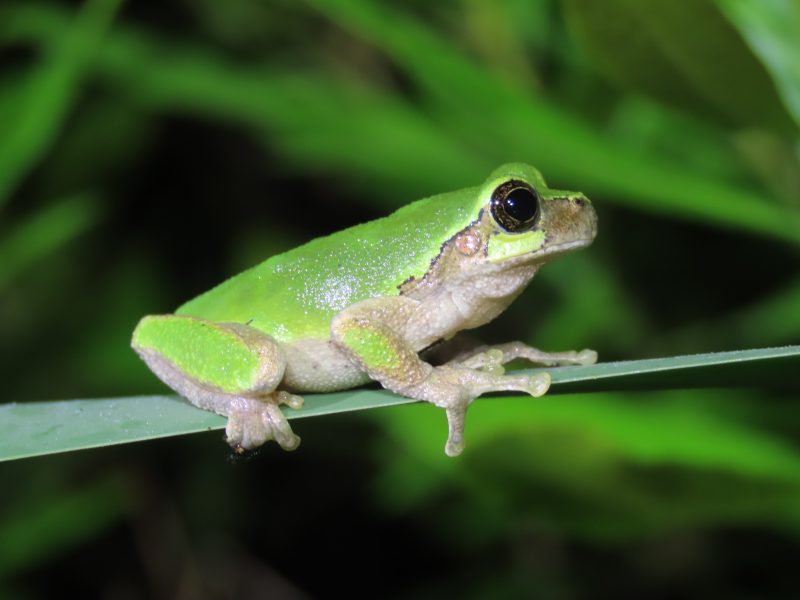
The Bird-voiced Treefrog is a small arboreal species, usually 1.25 to 2 inches long. It has smooth green or grayish skin with a pale stripe along each side of the body. Its eyes are large and prominent, aiding nocturnal activity. The species gets its name from its loud, bird-like call used to communicate during the breeding season.
Primarily nocturnal, Bird-voiced Treefrogs spend most of their time in shrubs, trees, and low vegetation near water. They feed on insects, spiders, and other small arthropods. Their climbing ability is aided by expanded toe pads, allowing them to grip leaves and branches securely. Predators include snakes, birds, and larger amphibians, though camouflage helps reduce risk.
Bird-voiced Treefrogs inhabit forested wetlands, swamps, and floodplains throughout Georgia. Breeding takes place in spring, when males call from low vegetation near temporary pools or ponds. Eggs are deposited in water, and tadpoles develop over several weeks before metamorphosing into terrestrial juveniles. Their dependence on both water and vegetation makes habitat conservation important for their survival.
Cope’s Gray Treefrog (Dryophytes chrysoscelis)
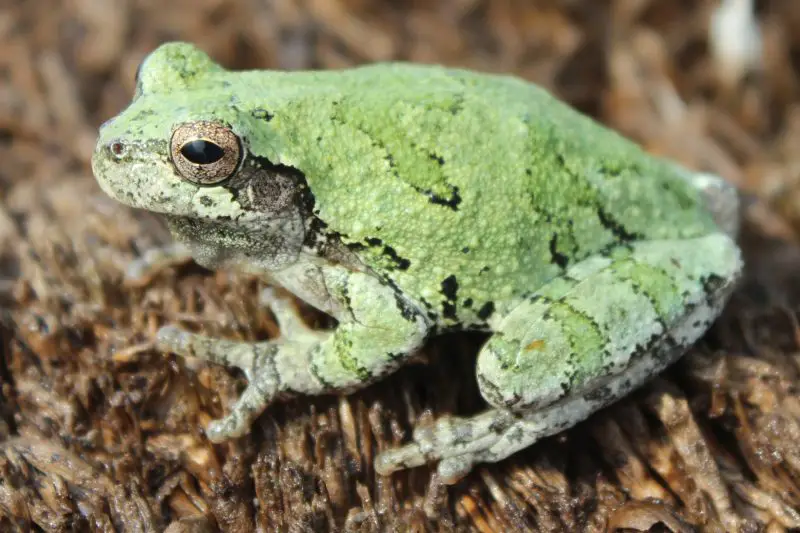
Cope’s Gray Treefrog is a small to medium-sized frog, ranging from 1.25 to 2 inches long. Its skin is gray or green with darker blotches, allowing it to blend into tree bark or leaves. This species has enlarged toe pads for climbing and vertical pupils, which enhance night vision. A unique trait is its rapid, high-pitched trill, which males use during breeding season.
This nocturnal frog is arboreal, often residing in trees, shrubs, and other vegetation near water sources. It feeds on insects and other small invertebrates, capturing prey with its sticky tongue. Its camouflage and agility help evade predators, including snakes, birds, and larger frogs. Cope’s Gray Treefrog can survive in both natural and suburban environments if adequate vegetation is present.
In Georgia, Cope’s Gray Treefrogs breed in temporary ponds, ditches, or small depressions filled with water. Males vocalize loudly to attract females, who lay clusters of eggs in the water. Tadpoles hatch quickly and metamorphose into juvenile frogs within a few weeks. This species is widespread across Georgia, thriving in forested areas, wetlands, and even backyards with sufficient cover.
Green Treefrog (Dryophytes cinereus)

The Green Treefrog is a small, bright green frog, typically ranging from 1.25 to 2.25 inches long. Its smooth skin often features a narrow white or yellow stripe along each side of the body. This species has large, sticky toe pads that enable it to climb trees, shrubs, and other vertical surfaces. Its striking green color helps it camouflage among foliage.
Green Treefrogs are nocturnal and primarily arboreal, although they may occasionally be found near the ground or in water. They feed on insects, spiders, and other small invertebrates, capturing prey with their quick, sticky tongues. Their loud, nasal call, often described as a “quonk,” is frequently heard during the spring and summer breeding seasons.
In Georgia, Green Treefrogs inhabit wetlands, swamps, ponds, and forested areas with abundant vegetation. Breeding occurs in shallow water bodies, where males call from low vegetation to attract females. Eggs are laid in clusters, and tadpoles hatch and develop over several weeks, eventually leaving the water as juvenile frogs. Their adaptability allows them to thrive in both natural wetlands and suburban habitats with ponds or gardens.
Pine Woods Treefrog (Dryophytes femoralis)
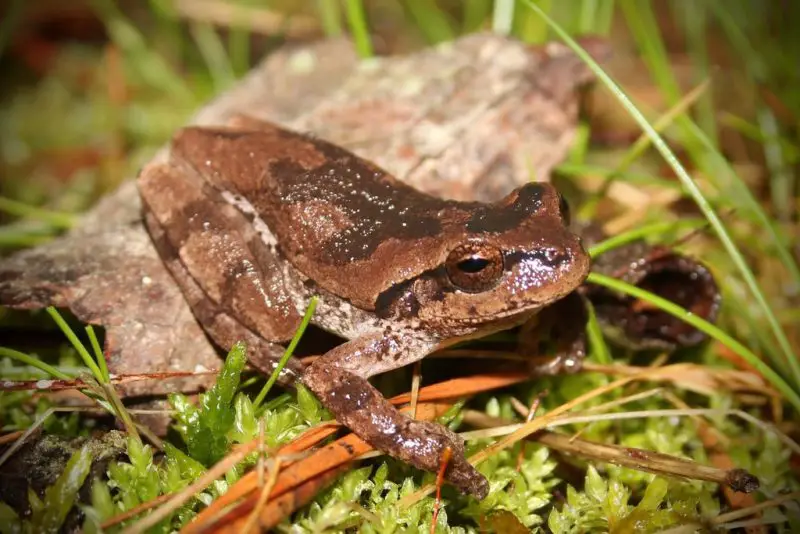
The Pine Woods Treefrog is a small treefrog, usually 1.25 to 2 inches long, with smooth skin that ranges from gray to pale green or yellow. It often has a distinctive pale stripe along each side and darker markings on its back. Its small size and coloration make it well-camouflaged among pine needles and leaf litter in its preferred habitat.
This species is nocturnal and primarily arboreal, spending most of its time in shrubs, trees, and low vegetation. Pine Woods Treefrogs feed on small insects, spiders, and other arthropods. They are adept climbers thanks to their toe pads, and their vocalizations—a short, high-pitched “queenk” call—help males attract mates during the breeding season.
Pine Woods Treefrogs are typically found in pine forests, swamps, and wetland areas throughout Georgia, especially in the southern and coastal plains. Breeding occurs in temporary pools or flooded depressions, often triggered by heavy rains. Eggs are laid in clusters, and tadpoles undergo rapid development to metamorphose before pools dry. Their reliance on ephemeral water bodies makes seasonal rains critical for successful reproduction.
Barking Treefrog (Dryophytes gratiosus)
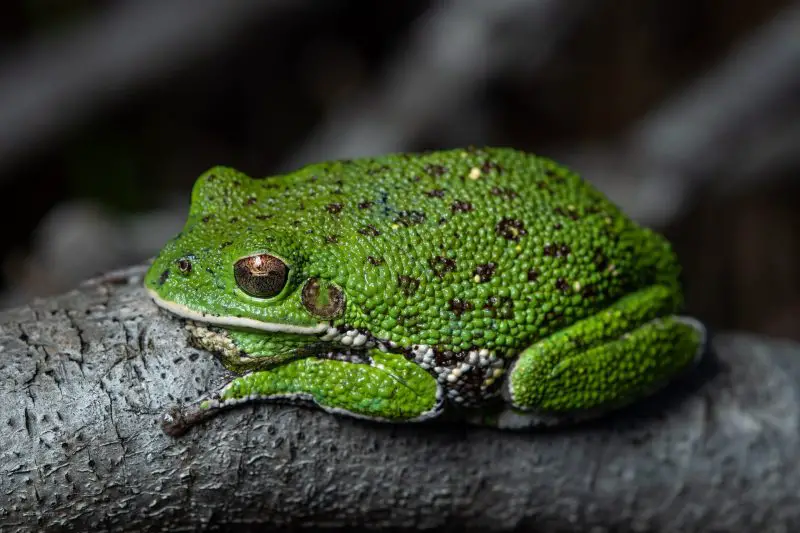
The Barking Treefrog is one of the largest treefrogs in Georgia, reaching 2 to 3.5 inches in length. Its smooth skin is bright green or gray, with darker blotches for camouflage. The species gets its name from its loud, barking-like call, which males use during the breeding season to attract females. It has prominent toe pads that aid in climbing trees and shrubs.
This nocturnal frog is primarily arboreal, though it may sometimes be found near water or on the ground. Its diet consists of insects, spiders, and other small invertebrates. The Barking Treefrog is well-camouflaged and uses its color patterns and still posture to avoid predators such as snakes, birds, and larger amphibians.
In Georgia, Barking Treefrogs inhabit pine flatwoods, forested wetlands, and swamps. Breeding occurs in temporary pools, ponds, or ditches, usually following heavy rainfall. Eggs are deposited in clusters in shallow water, and tadpoles metamorphose within several weeks. Their large size and loud call make them easy to identify during the breeding season.
Squirrel Treefrog (Dryophytes squirellus)
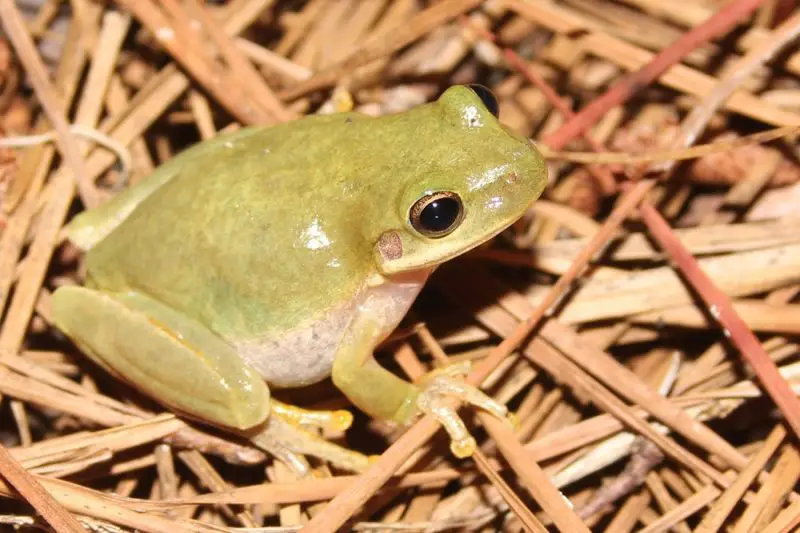
The Squirrel Treefrog is a small, agile frog measuring 0.75 to 1.5 inches long. Its skin is smooth and variable in color, ranging from gray to green or brown, allowing it to blend with tree bark, leaves, or pine needles. Its toe pads are well-developed for climbing, and its slender body enables rapid movements.
This species is nocturnal and highly arboreal, often found in trees, shrubs, or low vegetation near water. Its diet primarily consists of ants, small beetles, and other invertebrates. Squirrel Treefrogs rely on camouflage and quick movements to evade predators such as snakes, birds, and larger frogs. Their small size and agility make them difficult to spot in their natural habitat.
Squirrel Treefrogs are common throughout Georgia, especially in forests, wetlands, and suburban areas with vegetation. Breeding occurs in temporary ponds, flooded ditches, or shallow depressions, usually after heavy rains. Eggs hatch into tadpoles that rapidly develop and metamorphose into juvenile frogs. This species’ adaptability allows it to thrive in both natural and altered habitats.
Spring Peeper (Pseudacris crucifer)
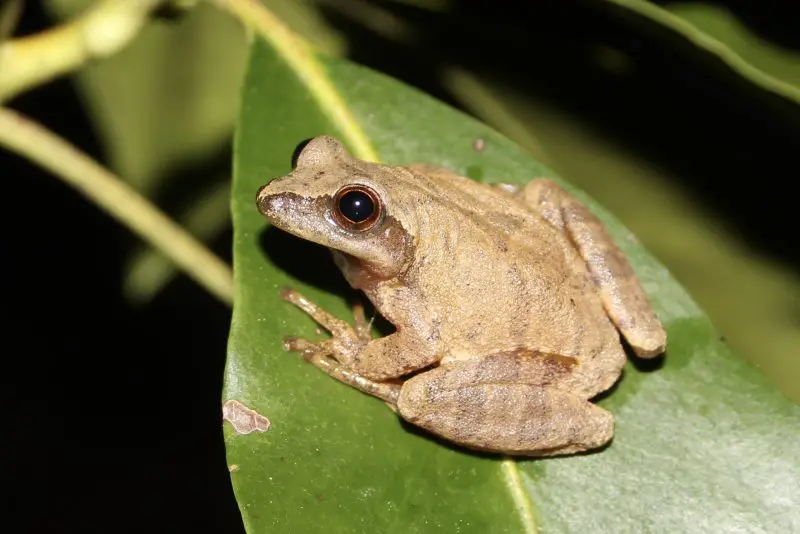
The Spring Peeper is a tiny chorus frog, measuring only 0.75 to 1.25 inches long. Its skin is smooth and usually tan or brown, marked with a distinctive dark X-shaped pattern on its back. Its small size and muted colors allow it to blend easily with leaf litter and vegetation in wetlands and forests.
Spring Peepers are primarily nocturnal and spend much of their time hidden in vegetation or under leaves. Their diet consists of small insects and invertebrates, captured with their sticky tongues. Males are famous for their loud, high-pitched peeping calls, which are often one of the first signs of spring in Georgia.
In Georgia, Spring Peepers inhabit wetlands, swamps, forests, and floodplain areas. Breeding occurs in temporary ponds and shallow pools during early spring, triggered by warm rainfall. Females lay eggs in water, and tadpoles develop over several weeks before transforming into juvenile frogs. Their small size and seasonal calling make them highly recognizable and widely distributed.
Upland Chorus Frog (Pseudacris feriarum)
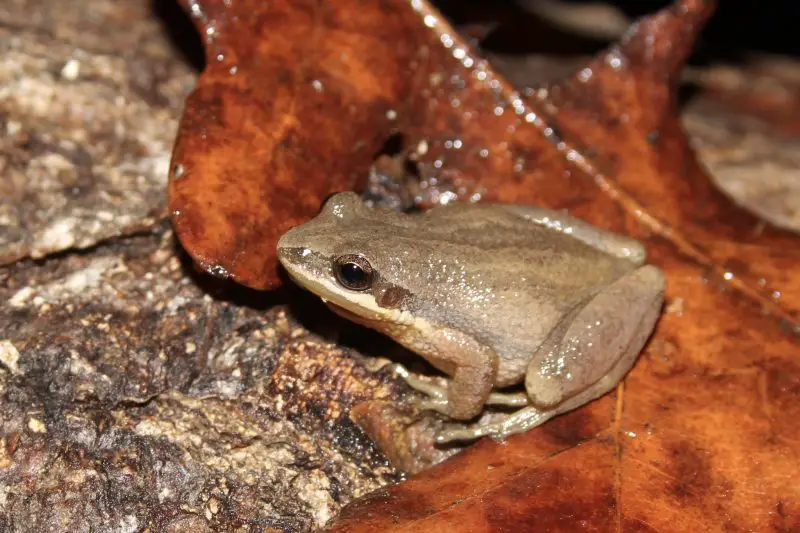
The Upland Chorus Frog is a small frog, typically 0.75 to 1.25 inches long. Its smooth skin ranges from brown to gray with three dark longitudinal stripes running along its back, giving it a striped appearance. Its slender body and long legs allow it to make short, quick hops, and its small size makes it well-camouflaged among grass and leaf litter.
Upland Chorus Frogs are nocturnal and spend most of their time near the ground in grassy areas or forest edges. They feed on tiny insects, spiders, and other invertebrates, using their sticky tongues for swift capture. Males produce a short, trilling call during the breeding season, which is often heard in early spring after heavy rains.
In Georgia, this species inhabits open woodlands, fields, and wetlands, particularly in the Piedmont and coastal plains. Breeding occurs in temporary pools and shallow water bodies, where females lay clusters of eggs. Tadpoles develop rapidly in these ephemeral environments, ensuring survival before the water evaporates. Their adaptability allows them to thrive in both natural and human-modified habitats.
Southern Chorus Frog (Pseudacris nigrita)
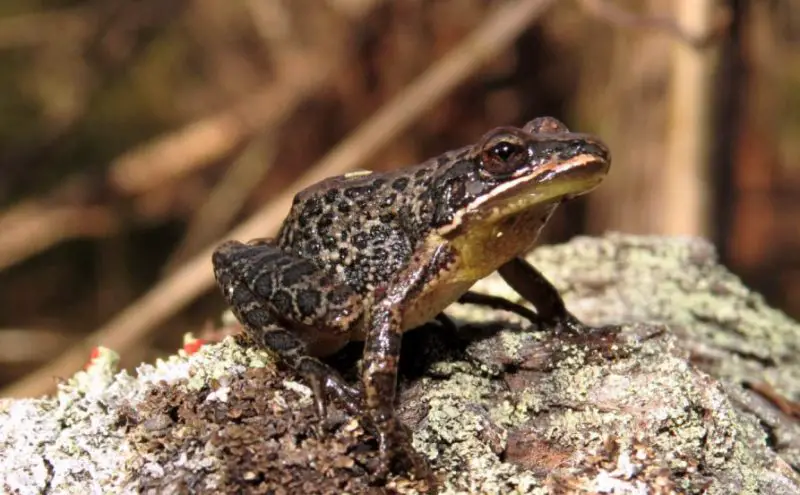
The Southern Chorus Frog is a small frog, typically 0.75 to 1.25 inches in length. Its skin color varies from gray to brown or olive, marked with three dark stripes along its back. Its slender body, long legs, and small size make it highly agile and able to hide easily among grass and leaf litter.
This nocturnal frog feeds primarily on small insects, spiders, and other invertebrates. Its vocalizations, consisting of a series of short, high-pitched trills, are used by males during the breeding season to attract females. Predators include snakes, birds, and larger amphibians, but camouflage and quick movements help them avoid predation.
Southern Chorus Frogs inhabit grassy fields, wetlands, and forest edges throughout Georgia. Breeding occurs in temporary pools or shallow ditches during spring rains. Eggs are laid in clusters, and tadpoles develop rapidly, completing metamorphosis in just a few weeks. Their reliance on ephemeral water bodies makes them highly responsive to seasonal rainfall patterns.
Little Grass Frog (Pseudacris ocularis)
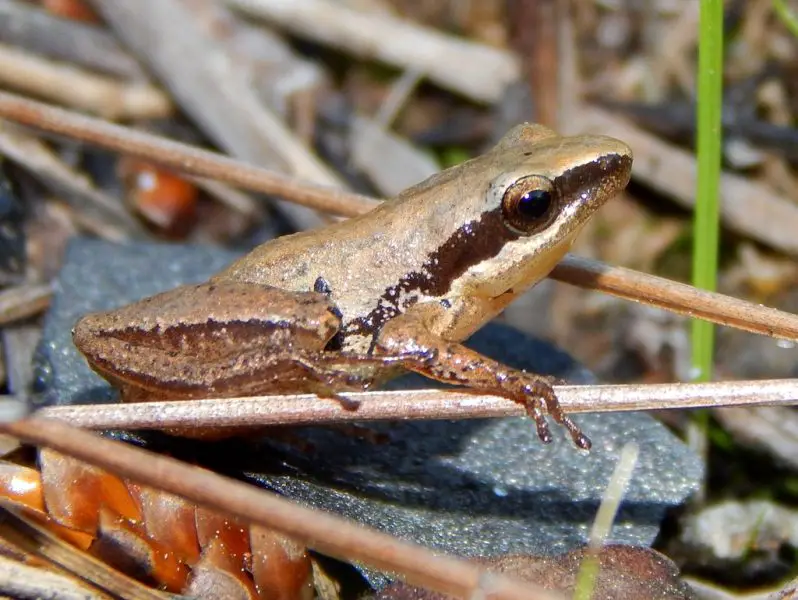
The Little Grass Frog is one of Georgia’s smallest frogs, measuring only 0.5 to 0.75 inches long. Its skin is smooth and generally gray or light brown, often with a faint stripe along its back. Its tiny size and slender body allow it to easily hide among grass, moss, or leaf litter, making it highly cryptic.
This species is primarily nocturnal and rarely climbs, preferring low vegetation or grasses. It feeds on minute insects and other invertebrates, capturing prey with its sticky tongue. Despite its small size, males produce a high-pitched, rapid trill to attract females during the breeding season. Predators include spiders, larger frogs, and birds, but its small size and camouflage offer protection.
Little Grass Frogs are widespread throughout Georgia, favoring grassy wetlands, marsh edges, and moist fields. Breeding occurs in temporary rain pools or shallow ponds, often in early spring. Eggs hatch quickly, and tadpoles metamorphose into terrestrial juveniles within a few weeks. Their diminutive size and secretive nature make them easy to overlook despite their abundance.
Ornate Chorus Frog (Pseudacris ornata)
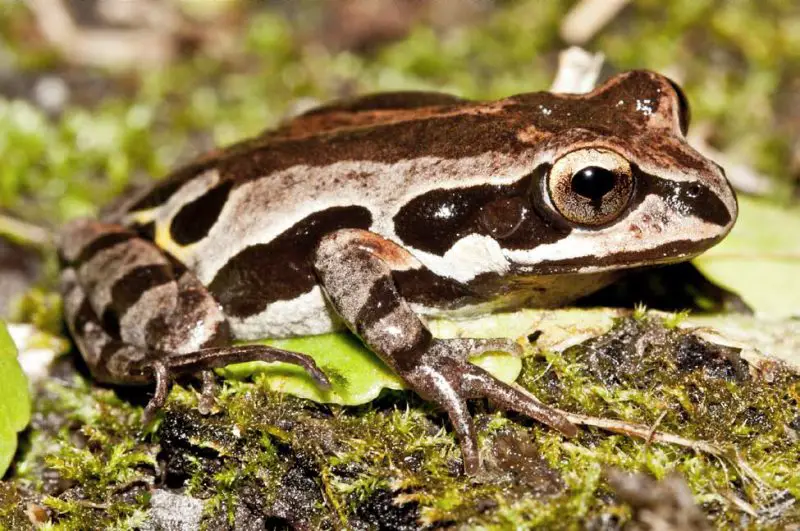
The Ornate Chorus Frog is a small frog, generally 0.75 to 1.25 inches long. Its skin is smooth and tan, brown, or reddish, featuring distinctive dark blotches or stripes along the back. Its body is slender, and the legs are long, allowing it to hop quickly through grasses and low vegetation.
Ornate Chorus Frogs are nocturnal and often found near the edges of wetlands, marshes, and temporary ponds. They feed on small insects, spiders, and other invertebrates, using their sticky tongues to catch prey. Males are highly vocal during the breeding season, producing a short, bird-like trill to attract mates. Predators include snakes, birds, and larger frogs, but camouflage helps them remain hidden.
In Georgia, Ornate Chorus Frogs inhabit coastal plains, wet pine forests, and grassy wetlands. Breeding takes place in temporary pools or rain-filled depressions during spring. Eggs are laid in clusters, and tadpoles develop rapidly to leave the water before it dries. Their adaptability to ephemeral habitats allows them to maintain healthy populations despite seasonal fluctuations in water availability.
Gopher Frog (Lithobates capito)
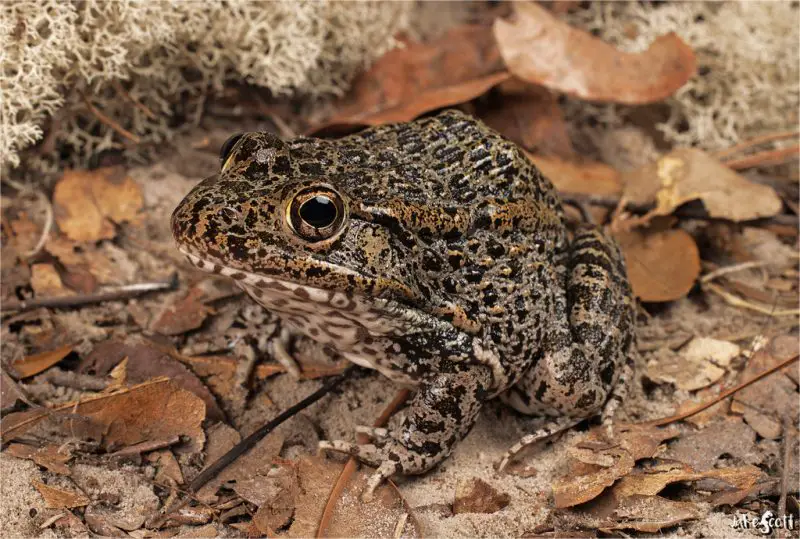
The Gopher Frog is a medium-sized frog, ranging from 2 to 4 inches long. Its skin is rough and gray or brown with darker spots, and its stocky body makes it well-suited for burrowing. One of its most distinctive features is its preference for sandhill habitats and its association with gopher tortoise burrows, which it uses for shelter.
Gopher Frogs are primarily nocturnal and terrestrial. They feed on insects, spiders, and other invertebrates. Their strong legs allow them to hop efficiently over uneven terrain, while burrowing provides protection from predators like snakes and birds. Males produce a deep, guttural call during breeding season to attract females.
In Georgia, Gopher Frogs inhabit sandy soils, pine flatwoods, and upland habitats. Breeding occurs in temporary ponds or isolated wetlands during heavy rains. Females lay eggs in shallow water, and tadpoles undergo rapid development to metamorphose into juvenile frogs before pools dry. Their dependence on burrows and ephemeral wetlands makes them highly sensitive to habitat disturbance.
American Bullfrog (Lithobates catesbeianus)
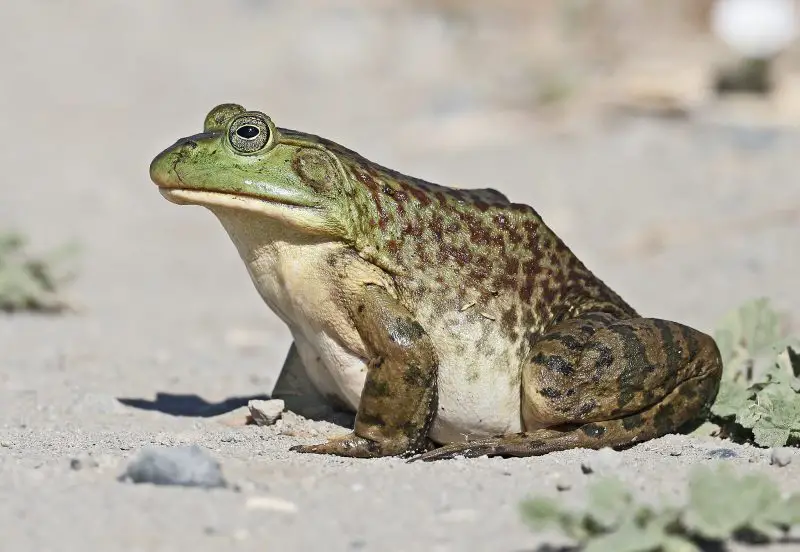
The American Bullfrog is one of the largest frogs in Georgia, reaching 3 to 6 inches in length. Its skin is smooth and olive-green to brown with darker blotches along the back. A distinguishing feature is the large tympanum (eardrum) visible behind the eyes, which is particularly prominent in males. Bullfrogs have powerful hind legs suited for long jumps and swimming.
Bullfrogs are highly aquatic, residing in ponds, lakes, and slow-moving streams. They are primarily nocturnal hunters, feeding on insects, small fish, amphibians, and even small mammals. Their large size and powerful jaws make them formidable predators, while their deep, resonant calls are a common sound near water during the breeding season.
In Georgia, American Bullfrogs breed in permanent water bodies, laying thousands of eggs in large gelatinous clusters. Tadpoles can take several months to over a year to metamorphose into adult frogs. Their adaptability to various aquatic habitats has allowed them to thrive across the state, sometimes outcompeting smaller native frog species.
Green Frog (Lithobates clamitans)
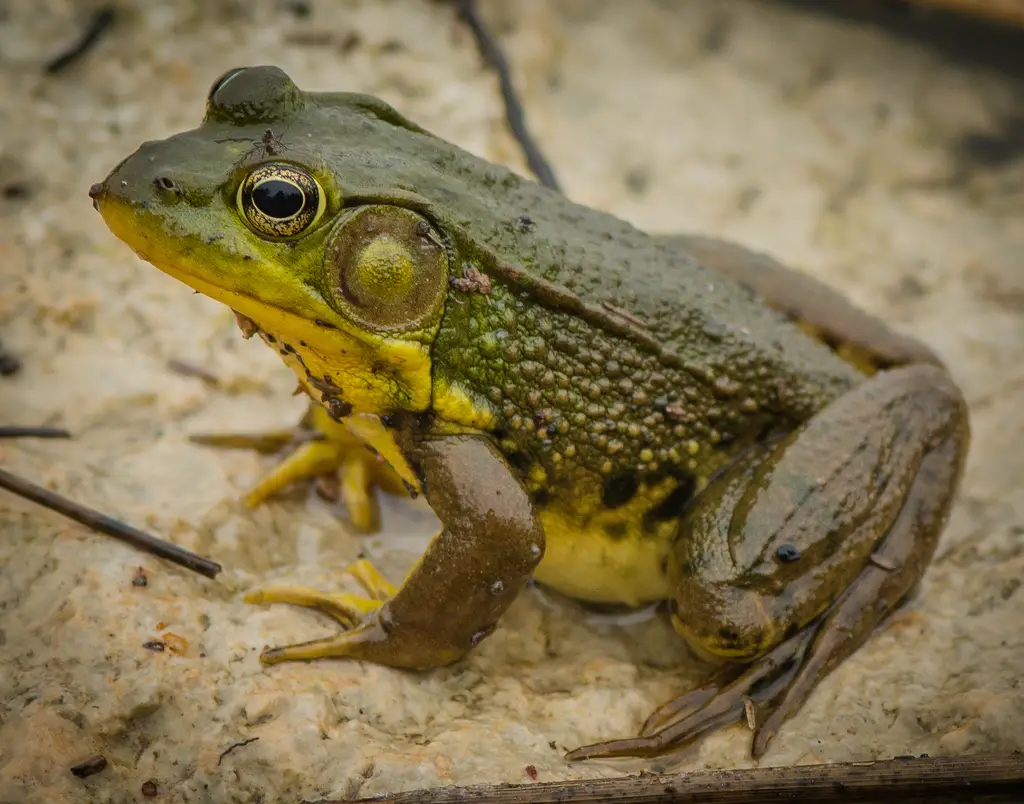
The Green Frog is a medium-sized species, measuring 2 to 4 inches long. Its skin is green to brown with irregular dark blotches and a prominent dorsolateral ridge running along each side of the back. The species is often mistaken for a bullfrog but can be distinguished by its smaller size and distinctive call resembling a plucked banjo string.
Green Frogs are semi-aquatic, often found along the edges of ponds, streams, and wetlands. They are primarily nocturnal but may be active during the day in shaded areas. Their diet consists of insects, spiders, and small aquatic animals, which they capture with quick tongue strikes. Predators include snakes, birds, and larger frogs.
In Georgia, Green Frogs breed in permanent and semi-permanent water bodies. Males vocalize from the water’s edge to attract females, and eggs are laid in clusters attached to submerged vegetation. Tadpoles develop over several months before metamorphosing into juvenile frogs. Their adaptability allows them to inhabit both natural and human-modified aquatic environments.
Pig Frog (Lithobates grylio)
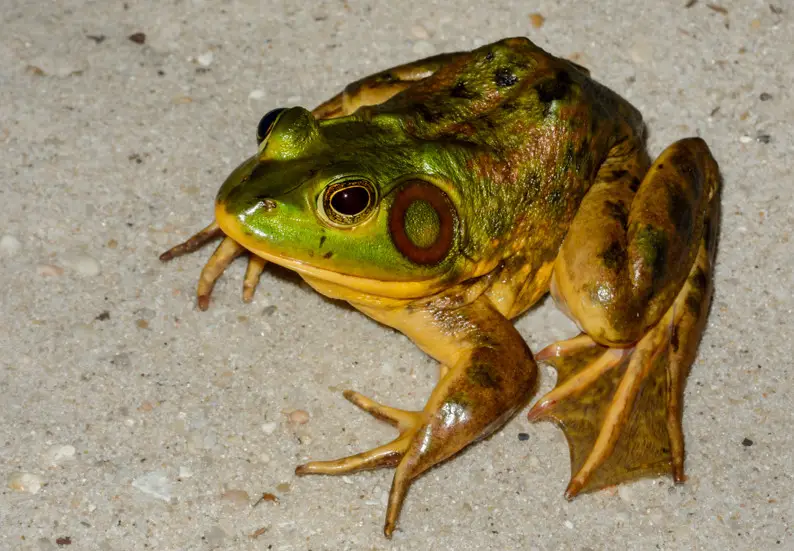
The Pig Frog is a large, robust frog, typically 4 to 7 inches long. Its skin is olive-green to gray, often with darker spots or blotches, and the tympanum is very large and noticeable. Its name derives from its pig-like grunting call, which males use during the breeding season. Pig Frogs have strong legs for swimming and short hops on land.
This species is highly aquatic, living in ponds, swamps, and slow-moving rivers. They feed primarily on insects, crayfish, small fish, and occasionally smaller frogs. Their nocturnal habits, large size, and vocalizations make them dominant predators in their aquatic habitats.
Pig Frogs in Georgia breed in permanent wetlands during spring and summer. Females lay thousands of eggs in clusters attached to vegetation. Tadpoles grow rapidly in warm waters, metamorphosing in several months. Their dependence on aquatic habitats makes them sensitive to water quality and wetland conservation.
River Frog (Lithobates heckscheri)
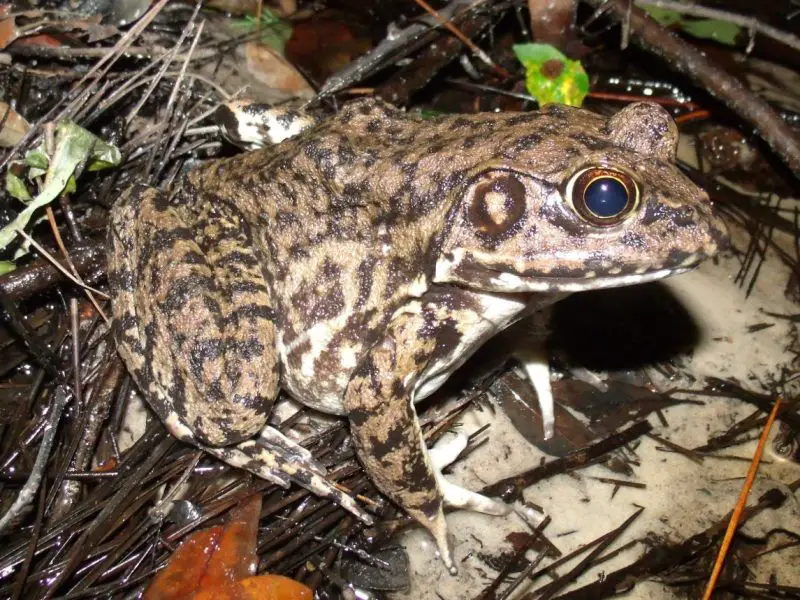
The River Frog is a medium to large species, ranging from 3 to 5 inches long. Its skin is smooth with olive-green or brown coloration, marked with darker spots. It has a broad head and a robust body, with a dorsolateral ridge extending along each side. Its long legs enable both swimming and strong leaps on land.
River Frogs are aquatic, inhabiting slow-moving streams, swamps, and river edges. They are nocturnal predators, feeding on insects, crayfish, and small aquatic animals. Their cryptic coloration and ability to leap quickly help them avoid predators such as snakes and birds.
In Georgia, River Frogs breed in permanent water bodies. Males call from shallow areas to attract females, who lay eggs in clusters attached to vegetation. Tadpoles develop over several months before metamorphosing into terrestrial juveniles. Their reliance on clean, permanent water makes them vulnerable to habitat degradation and pollution.
Southern Leopard Frog (Lithobates sphenocephalus)
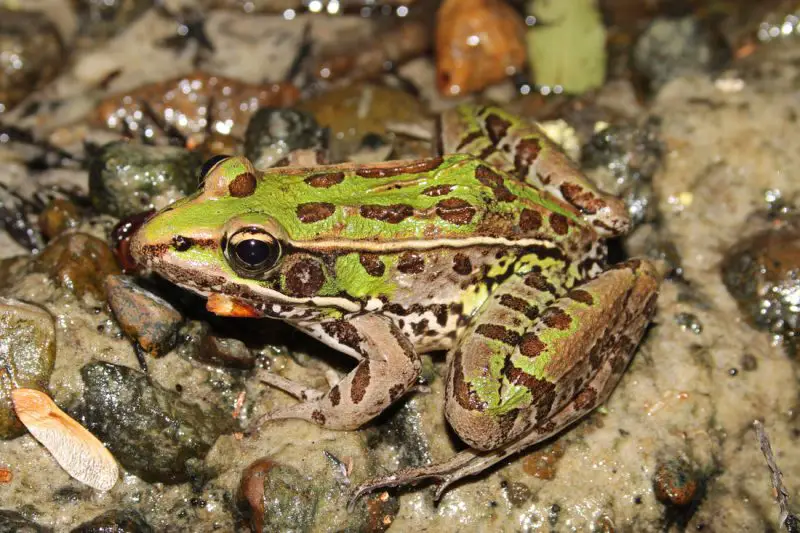
The Southern Leopard Frog is a medium-sized frog, typically 2.5 to 4 inches long. Its skin is green or brown with distinct dark spots resembling a leopard pattern. A prominent dorsolateral ridge runs along each side of its back, and its long legs make it an excellent jumper. This species is agile and often found near water.
Southern Leopard Frogs are semi-aquatic and mainly nocturnal. They feed on insects, spiders, and other small invertebrates, occasionally consuming smaller frogs. Their loud, snore-like call is characteristic during the breeding season and helps males attract females. Predators include snakes, birds, and larger amphibians.
In Georgia, Southern Leopard Frogs inhabit ponds, marshes, and slow-moving streams, often in grassy or forested areas nearby. Breeding occurs in early spring in shallow water bodies. Eggs are laid in clusters, and tadpoles develop over several weeks to months before metamorphosing into juvenile frogs. Their adaptability allows them to occupy a wide range of freshwater habitats throughout the state.
American Toad (Anaxyrus americanus)
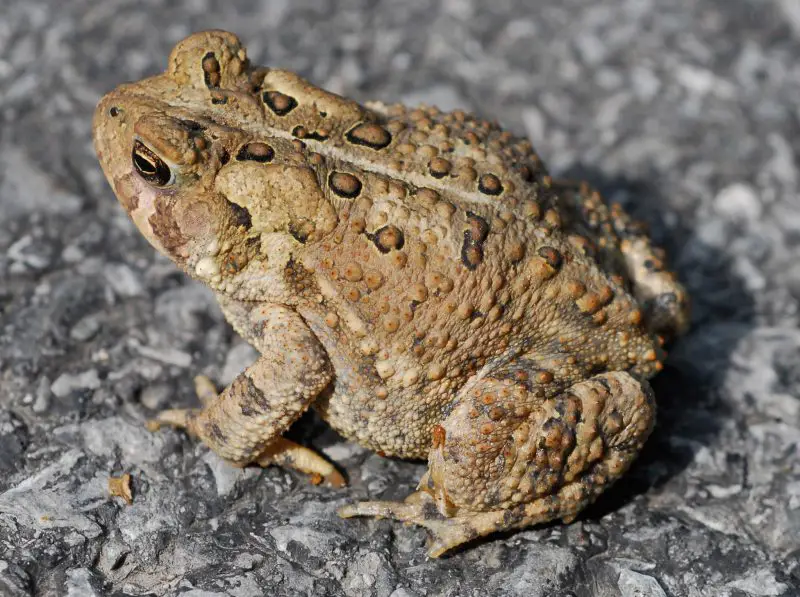
The American Toad is a medium-sized toad commonly found throughout Georgia. Adults typically range from 2 to 4 inches in length, with a robust, warty body covered in brown or grayish skin that often features dark spots. Its distinctive short legs and broad head help distinguish it from other toads. During the breeding season, males develop dark throat patches, which they use for vocalizing to attract females.
This species is primarily nocturnal and terrestrial, often hiding under logs, leaf litter, or stones during the day to avoid predators. Its diet mainly consists of insects, spiders, and other small invertebrates, which it captures with a sticky tongue. The American Toad uses a combination of hopping and crawling to move, making it versatile across various terrains.
American Toads breed in shallow freshwater bodies such as ponds, ditches, and slow-moving streams. Males produce a high-pitched trill that can last several seconds and may carry over long distances. Eggs are laid in long, gelatinous strings attached to vegetation. Tadpoles hatch within days and undergo metamorphosis over several weeks, eventually leaving the water as fully formed juvenile toads.
Fowler’s Toad (Anaxyrus fowleri)
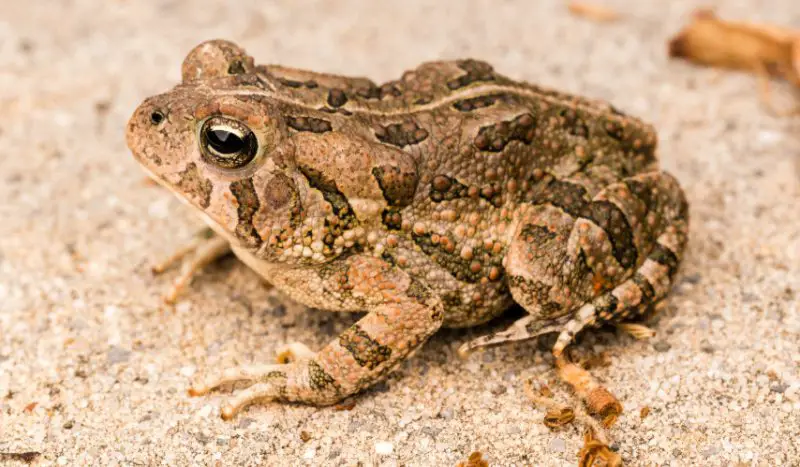
Fowler’s Toad is a small to medium-sized toad, typically ranging from 2 to 3.5 inches long. Its skin is warty with a light brown, gray, or olive coloration, often marked by three or more dark blotches along its back. One key identification feature is the presence of one or two small warts in the dark spots, distinguishing it from the American Toad. Males tend to have darker throats and produce a nasal, short trill during mating season.
Fowler’s Toad is mainly nocturnal but can occasionally be seen during the day, especially in moist environments. Its diet consists of ants, beetles, and small insects. Like most toads, it uses its long sticky tongue to capture prey efficiently. Predators include snakes, birds, and larger mammals, though its toxic skin secretions provide some defense.
This species prefers sandy soils near rivers, lakes, or wetlands, making it abundant in Georgia’s coastal plains and Piedmont regions. Breeding occurs in shallow, temporary pools during spring and early summer. Females lay eggs in long gelatinous strands, and tadpoles hatch within a week. These tadpoles undergo rapid development, leaving the water in several weeks to join the terrestrial adult population.
Oak Toad (Anaxyrus quercicus)
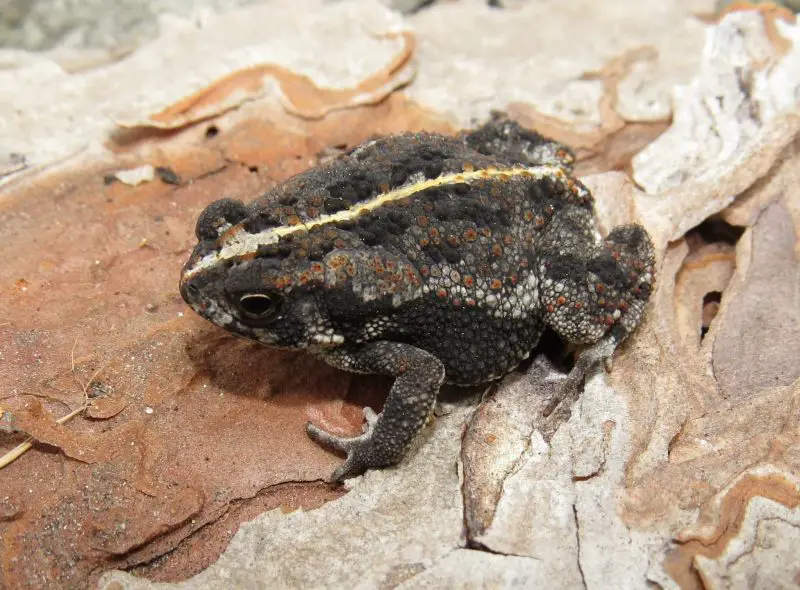
The Oak Toad is one of the smallest toads in Georgia, measuring only about 1 to 1.5 inches long. It has smooth, granular skin with a tan or light brown color, often highlighted by a pale stripe running down its back. Its diminutive size and light coloration make it highly camouflaged among pine needles, sand, and leaf litter in its natural habitats.
Oak Toads are primarily terrestrial and spend most of their time on the forest floor. They feed mainly on ants, termites, and tiny insects, capturing prey with quick tongue strikes. They are highly secretive and can be difficult to spot, often freezing in place to avoid detection. During the breeding season, males emit a short, high-pitched call to attract females.
Oak Toads are strongly associated with sandy pine flatwoods and scrub habitats in Georgia, especially in the southern regions. Breeding occurs in temporary rain-filled depressions, where females deposit eggs in small clusters. Tadpoles develop quickly in these ephemeral pools, allowing them to metamorphose before the water dries. This rapid life cycle helps Oak Toads thrive in environments that experience frequent seasonal drying.
Southern Toad (Anaxyrus terrestris)
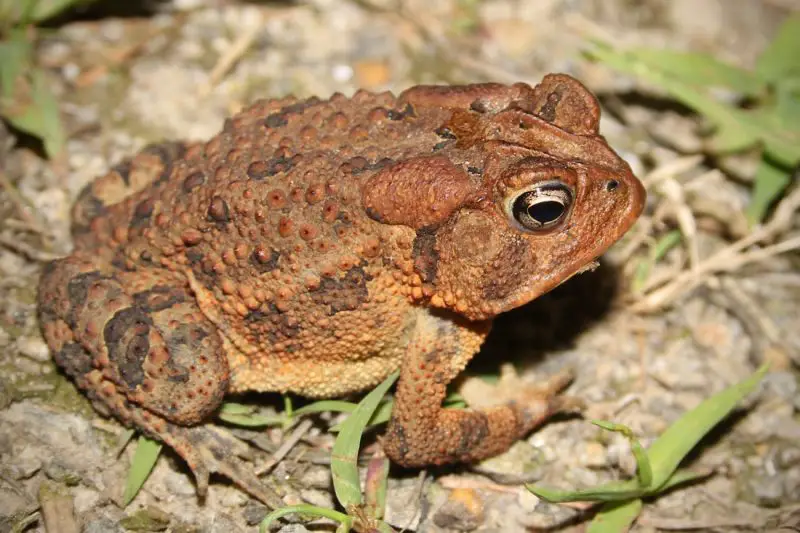
The Southern Toad is a medium-sized toad reaching 2.5 to 4 inches in length. Its skin is warty, usually gray or brown, with distinctive light-colored lines running down its back. Like other toads, it has short legs for walking and hopping rather than long jumps. Male Southern Toads have dark throat patches used in producing deep, musical trills during mating season.
This species is highly adaptable and primarily nocturnal. It forages at night for insects, spiders, and other small invertebrates, using its long sticky tongue to capture food. Its skin contains mild toxins that deter some predators, though snakes and birds remain major threats. During dry periods, Southern Toads burrow into the soil to maintain moisture and avoid heat stress.
Southern Toads prefer sandy soils near forests, fields, and wetlands. Breeding occurs in temporary pools, roadside ditches, or ponds, often triggered by heavy rainfall. Females lay long strings of eggs, which hatch in a few days. Tadpoles develop in water, feeding on algae and detritus before metamorphosing into juvenile toads. Their adaptability allows Southern Toads to thrive in a wide range of habitats throughout Georgia.
Eastern Narrowmouth Toad (Gastrophryne carolinensis)
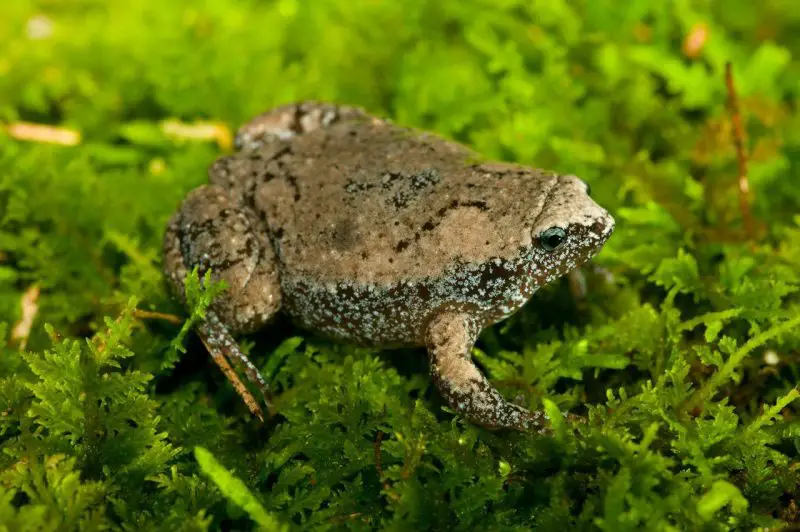
The Eastern Narrowmouth Toad is a small, stout amphibian measuring about 1 to 1.5 inches in length. Its skin is smooth and dark brown or gray, often with a subtle stripe running down the back. Its most distinguishing feature is the pointed snout and a very narrow mouth, which gives the species its name. Unlike many toads, it lacks prominent parotoid glands and appears less warty.
This species is primarily nocturnal and secretive, spending most of its time hidden under logs, leaf litter, or loose soil. Its diet consists mainly of ants and small insects, which it captures with its sticky tongue. The Eastern Narrowmouth Toad relies on camouflage and burrowing to avoid predators such as snakes, birds, and larger amphibians.
Eastern Narrowmouth Toads inhabit moist forests, wetlands, and gardens throughout Georgia. Breeding occurs in temporary rain pools or shallow puddles, typically after heavy rains. Females lay clusters of eggs in water, and the tadpoles develop rapidly, transforming into terrestrial juveniles within a few weeks. Their small size and secretive behavior make them easy to overlook in the wild.
FAQs About Frogs in Georgia
What types of frogs are most common in Georgia?
Georgia is home to a wide variety of frogs and toads. The most common species include the American Toad, Fowler’s Toad, Green Treefrog, Spring Peeper, and Southern Leopard Frog. Many species thrive in wetlands, ponds, rivers, and forested areas.
How can I identify different frogs in Georgia?
Frogs can be identified by their size, color, skin texture, markings, calls, and habitat. Treefrogs often have sticky toe pads for climbing, while toads have warty, dry skin and shorter legs. Listening to their distinctive calls is also an effective way to identify them.
When is the best time to observe frogs in Georgia?
Frogs are most active during warm, rainy periods, especially in spring and summer. Many species are nocturnal and can be heard calling after sunset. Temporary pools formed by rainfall are prime spots for observing breeding behavior.
Are any frogs in Georgia dangerous or poisonous?
Most Georgia frogs are harmless to humans. Some toads, like the American Toad, secrete mild toxins from their skin as a defense mechanism, but they are not dangerous if touched carefully. Avoid ingesting any wild amphibians.
How do frogs contribute to Georgia’s ecosystem?
Frogs play a crucial role in controlling insect populations and serve as prey for snakes, birds, and mammals. Their presence indicates healthy ecosystems, particularly wetlands and forested habitats. Tadpoles also help maintain water quality by feeding on algae and detritus.


